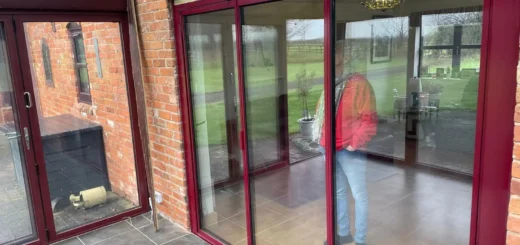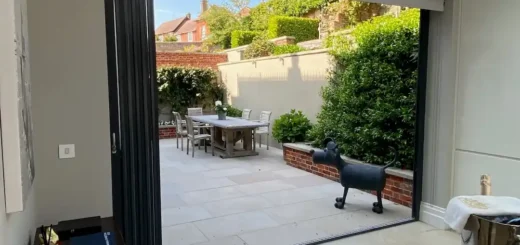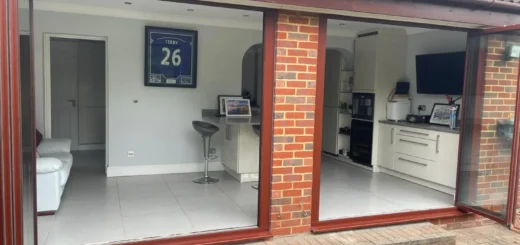Everything You Need to Know About Interior Sliding Doors
Table of Contents
What Are Interior Sliding Glass Doors?
Interior sliding doors offer a practical way to divide spaces in homes. These panels move along tracks, freeing up floor space and allowing for easy room separation. Glass versions of these doors are particularly popular for their ability to let light through while still providing a physical barrier.
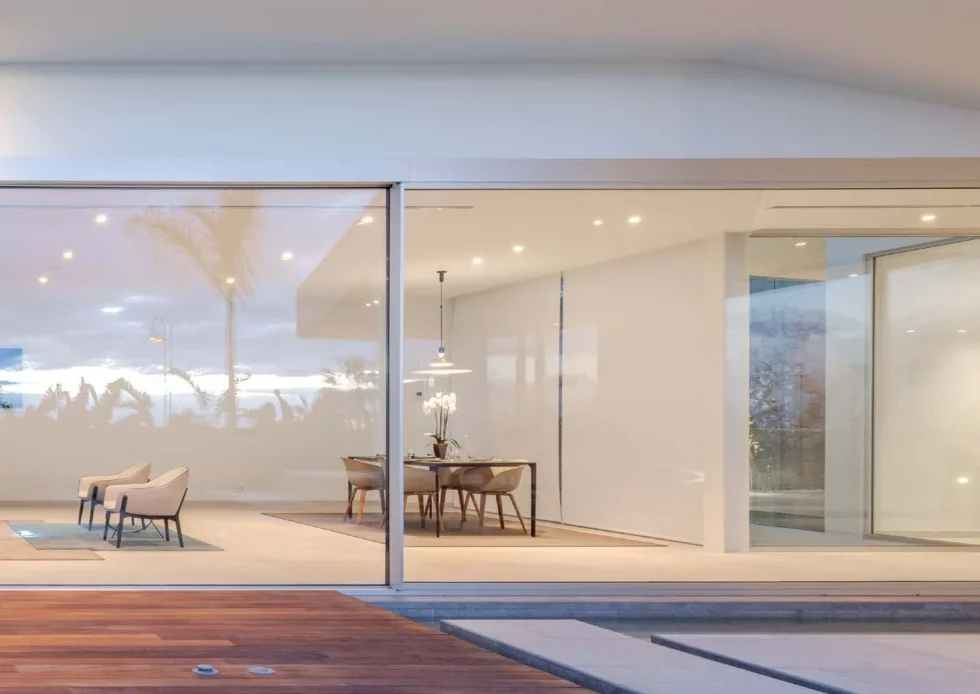
The track is a key part of any sliding door system. Often made from aluminium or stainless steel, it guides the door’s movement. High-quality rollers, usually with ball bearings, carry the door’s weight and enable quiet operation.
Glass forms the main part of these doors. Many interior glass sliding doors use tempered safety glass for durability. Those wanting more privacy might choose frosted or textured glass options.
Frames serve both practical and visual purposes. Some homeowners prefer frameless glass doors to increase light flow, while others select framed options in wood or metal to match their home’s style.
Types of Sliding Glass Door Systems
Pocket Doors
Pocket doors are a type of interior sliding door that tucks into the wall when open. They’re great for small spaces like bathrooms or compact bedrooms, where they can save up to 10 square feet compared to a swing door.
Installing pocket doors requires careful planning. The wall cavity must be strong enough to hold the door and wide enough to fit it completely. While they’re more complex to put in than other sliding door types, pocket doors are excellent space-savers.
Barn-Style Sliders
Barn-style sliding interior glass doors hang from a visible track above the doorway. This design adds an industrial look to rooms. Unlike pocket doors, you can often add barn-style sliders to existing homes without changing the walls.
One thing to note is that these doors cover part of the wall when open, which might affect where you can put furniture. However, many people like how these doors look and make them a feature of their room design.
Bypass Doors
Bypass systems use two or more panels that slide past each other on separate tracks. They’re often used for wardrobes and to divide rooms where space is tight.
While bypass sliding doors for interior use don’t open as wide as single-panel options, they’re flexible. You can partially open them to adjust privacy or control light between spaces.
Materials and Styles of Sliding Interior Doors
Glass Types
Clear glass is a common option for interior sliding doors, allowing maximum light flow between spaces. It’s ideal for creating an open feel in your home. However, some homeowners prefer frosted glass for areas where privacy is important, such as bathrooms or bedrooms.
Textured glass offers a middle ground for sliding interior doors. It allows light to pass through while obscuring clear visibility. Patterns range from subtle, like rain glass, to more pronounced designs that can become a decorative feature in themselves.
For those concerned about safety, tempered glass is the go-to choice for sliding doors for interior use. This specially treated glass is much stronger than regular glass and breaks into small, dull pieces if shattered, reducing the risk of injury.
Frame Materials
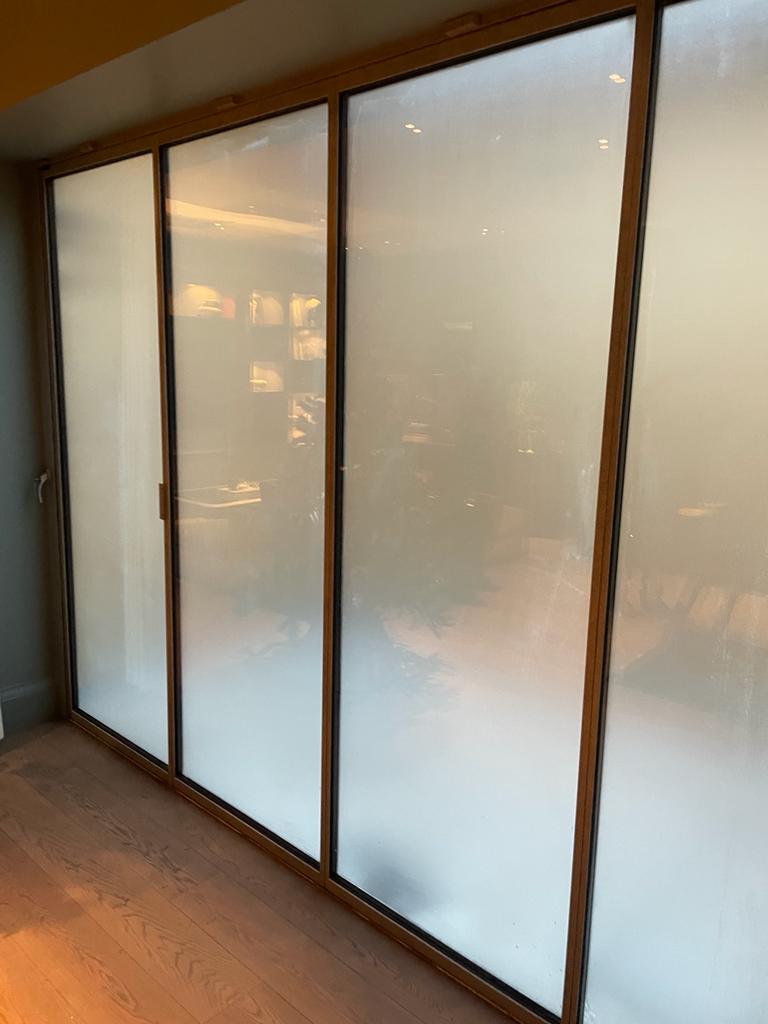
The frames of sliding interior glass doors play a major role in both appearance and durability. Aluminium frames are lightweight and low-maintenance, making them a practical choice for many homes. They can be powder-coated in various colours to match your décor.
Wooden frames bring warmth and a traditional touch to interior sliding doors. Oak, pine, and mahogany are popular choices, each offering unique grain patterns and colour tones. Wood frames can be stained or painted to complement your interior design.
For a more modern look, some homeowners opt for sleek, frameless sliding glass interior doors. These minimalist designs maximise the glass area, creating an almost invisible barrier between spaces when closed.
Hardware Choices
Handle designs range from simple flush pulls to more elaborate bar handles. Stainless steel and brushed nickel finishes are popular for their durability and modern appearance.
Whilst typically not as important as for sliding patio doors, locking mechanisms may be useful depending on your needs. While not always necessary for every door, they can provide added security and privacy where needed.
Soft-close mechanisms are becoming increasingly popular in sliding doors for interior use. These systems prevent the door from slamming shut, reducing noise and wear on the door components. They’re particularly useful in homes with children or in quiet areas like libraries or home offices.
Sliding Glass Doors in Home Design
Interior sliding doors can reshape your living spaces, offering flexibility and style. These movable panels allow you to adapt rooms to different needs throughout the day.
Creating Flexible Living Areas
Sliding doors for interior use excel at dividing larger spaces into distinct zones. In open-plan homes, they provide the option to separate areas when needed without permanently breaking up the space.
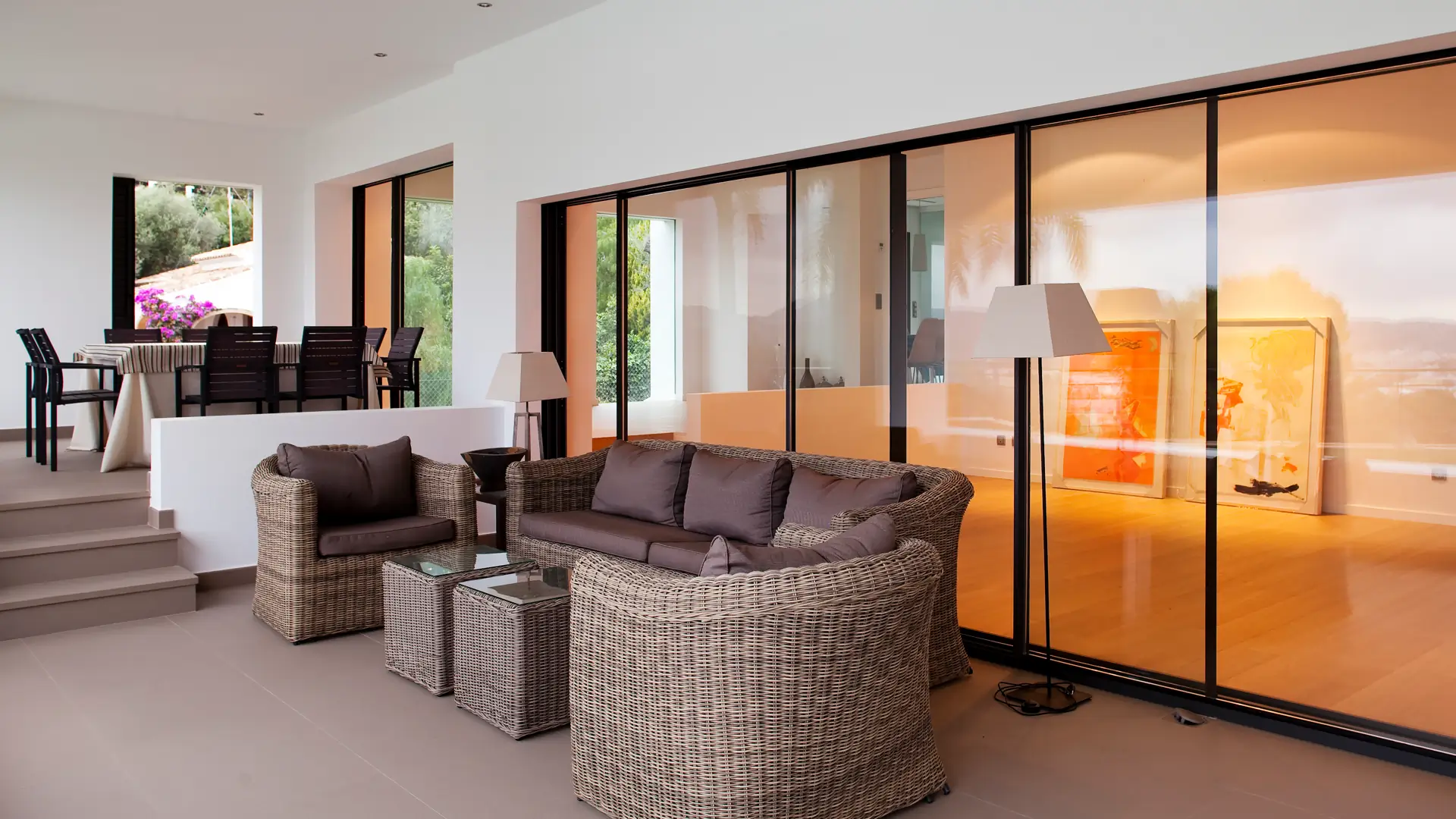
Many homeowners now use sliding interior doors to create temporary work areas. A glass partition can quickly turn a corner of your living room into a home office. When the workday ends, simply slide the door open to reconnect with the rest of your home.
Interior sliding glass doors offer a clever solution for occasional guest accommodation. By installing these doors, you can swiftly convert a dining area or study into a private sleeping space. This flexibility is especially valuable in smaller homes where every square metre counts.
Making the Most of Natural Light
One of the key benefits of interior glass sliding doors is their ability to spread light throughout your home. Unlike solid doors, they allow sunlight to penetrate deeper into your living spaces.
Interior glass sliding doors, when placed near windows or patio doors, extend the view and make rooms feel larger and more open.
In homes with long hallways or interior rooms, sliding glass interior doors can make a big difference. By replacing solid doors with glass versions, you can borrow light from adjacent rooms, making previously dark areas feel brighter and more inviting.
Giving Compact Spaces a Roomier Feel
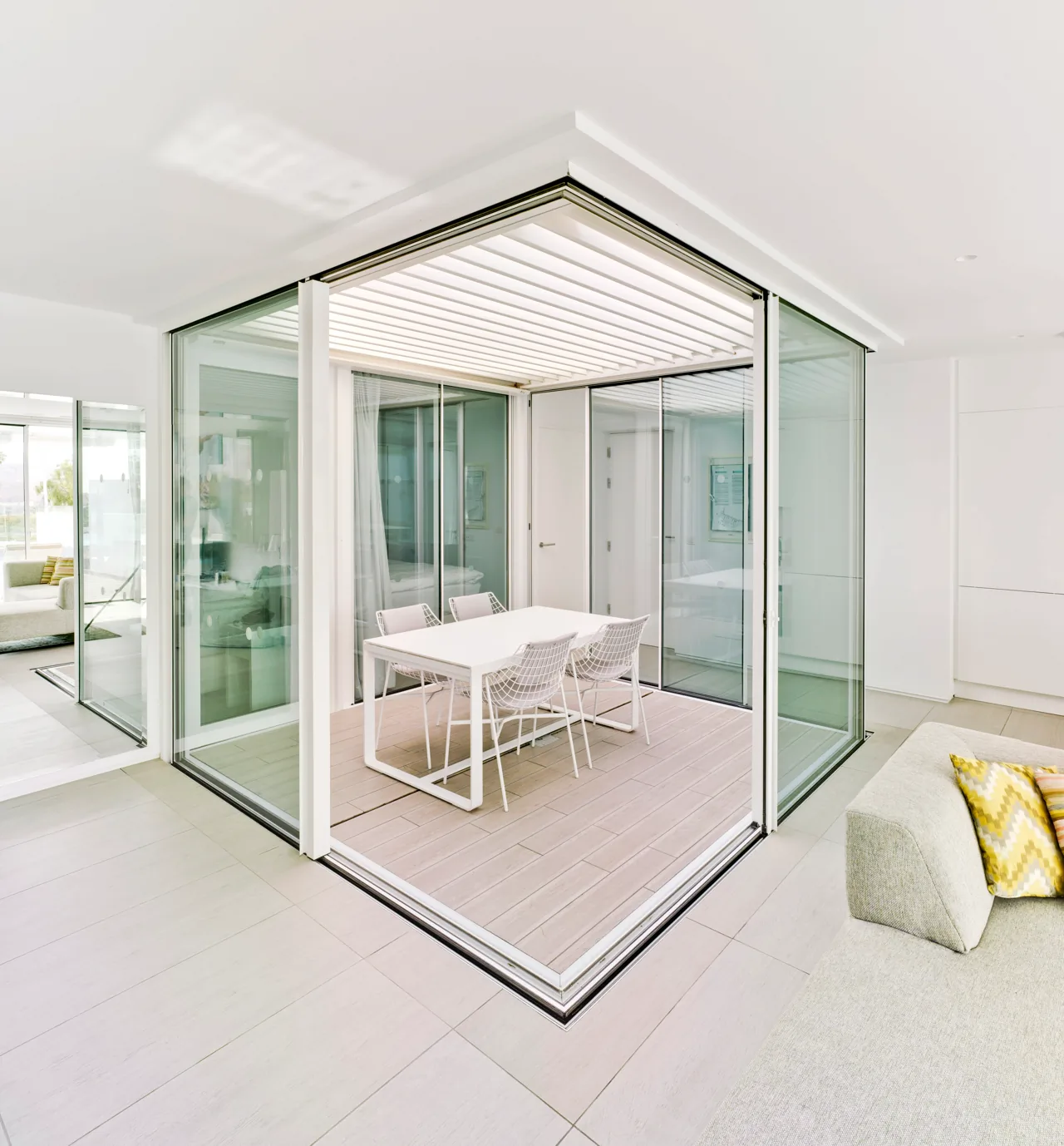
Interior sliding doors are a boon for compact living areas. Their space-saving design frees up floor area that would otherwise be taken up by a door’s swing arc.
In smaller kitchens, sliding interior doors can separate the cooking area from the dining space without consuming valuable floor area. Glass doors are particularly useful here, as they keep the kitchen connected visually while containing cooking odours and noise.
Sliding glass interior doors are also increasingly popular in bathroom design. They can separate the shower or toilet area without making the room feel cramped. The use of frosted or textured glass ensures privacy while still allowing light to filter through.
Style Integration
Sliding Interior Doors in Minimalist Homes
For those who prefer a clean, uncluttered look, frameless sliding interior doors are an excellent choice. These doors create an almost invisible barrier, allowing the eye to travel uninterrupted through spaces. In minimalist homes, glass interior sliding doors with slim tracks and hidden hardware can easily blend into the overall design.
Interior Sliding Doors in Traditional Settings
Sliding doors for interior use can also work well in more classic settings. Wood-framed glass doors, for instance, can add warmth and character to a traditional home. By choosing the right frame style and finish, interior sliding doors can harmonise with period features such as cornices or panelling.
Industrial Style Sliding Glass Interior Doors
The industrial aesthetic has gained popularity in recent years, and sliding interior glass doors fit perfectly into this style. Metal-framed doors with exposed hardware can create a raw, urban feel. In loft apartments or converted warehouses, large-scale sliding doors for interior use can become a striking architectural feature. A popular style currently is Georgian-style doors with horizontal integral bars.
Design Tips
Colour and Texture
While clear glass is a popular choice, interior sliding doors offer numerous opportunities for adding colour and texture to your space. Tinted glass can introduce subtle hues, while textured or patterned glass can become a decorative element in its own right. Some homeowners even opt for sliding interior doors with built-in integral blinds or shades for added privacy and light control.
Mixing Materials
Combining different materials in your sliding glass interior doors can create a unique look. For example, a wooden frame paired with frosted glass can offer a balance of warmth and modernity. In more eclectic interiors, sliding doors for interior use might feature a mix of glass panels and solid sections, allowing for both visibility and privacy.
Coordinating with Furnishings
When selecting interior sliding doors, consider how they’ll interact with your furniture and décor. In a room with bold colours or patterns, simple glass doors can provide a neutral backdrop. Conversely, in a more subdued space, sliding interior doors with interesting frames or glass textures can become a focal point.
Interior Sliding Doors – Things To Consider
Privacy
While glass sliding doors for interior use offer great visual connection, privacy can sometimes be a concern. Frosted or textured glass provides a simple solution, allowing light through while obscuring clear views. Some interior sliding doors come with built-in blinds or shades, offering adjustable privacy levels.
Noise
One common worry about sliding interior glass doors is their ability to block sound. While they may not be as effective as solid doors, many modern interior sliding doors come with sound-dampening features. Double-glazed panels can reduce noise transmission between rooms. Also, ensuring a tight seal when the door is closed can help minimise sound leakage. If noise is a major concern, look for sliding doors for interior use that are specifically designed for acoustic performance.
Temperature Control
Glass interior sliding doors can impact your home’s temperature regulation. In colder climates, they might allow heat to escape more readily than solid doors. However, double-glazed sliding interior doors can help mitigate this issue. In warmer areas, glass doors can be an advantage, allowing you to trap heat in specific rooms when needed. Some sliding doors for interior use even come with low-emissivity coatings, which can help maintain a consistent indoor temperature by reflecting heat back into the room.
Maintenance and Cleaning
Keeping your interior sliding doors in good condition requires regular maintenance. Glass panels need frequent cleaning to maintain their clarity, especially in high-traffic areas. The tracks of sliding interior doors should be kept free of dust and debris to ensure smooth operation. While this might seem like extra work, many homeowners find that the benefits of glass interior sliding doors outweigh the cleaning requirements. Regular maintenance can also extend the life of your doors, making them a long-lasting addition to your home.
Frequently Asked Questions About Interior Sliding Doors
What are the main types of interior sliding doors?
Interior sliding doors come in several varieties, each suited to different needs and spaces. Pocket doors slide into wall cavities, making them ideal for tight spaces. Bypass doors feature panels that slide past each other, commonly used for wardrobes. Barn-style doors hang from exposed tracks, adding a rustic touch to interiors. Slide and fold doors, also known as slide and turn or slide and pivot doors, combine sliding and folding mechanisms. These interior sliding doors can open up larger spaces by folding panels to one side.
What’s the difference between sliding and folding doors?
Sliding doors for interior use and folding doors operate on different principles. Interior sliding doors move along a single track, with panels gliding past one another or into a wall pocket. They’re great for saving space as they don’t swing out into the room. Sliding interior doors typically cover larger openings with fewer panels. Folding doors, on the other hand, consist of multiple panels that fold accordion-style when opened. They can cover wider openings than sliding doors but require more clearance space when open. Some systems, like slide and fold doors, combine both mechanisms. These sliding glass interior doors slide along a track and then fold to one side, offering flexibility for various opening sizes.
What are the pros and cons of frameless sliding doors?
Sliding frameless glass doors offer a sleek, modern aesthetic that many homeowners find appealing. The main advantage is their minimalist look, which can make spaces appear larger and more open. These sliding doors for interior use allow maximum light transmission and provide unobstructed views between rooms. They’re also easier to clean, with no frames to trap dust or dirt. However, frameless interior sliding doors do have some drawbacks. They typically cost more than framed options due to the need for thicker, tempered glass. Without frames, they may provide less insulation against sound and temperature changes. Installation can be trickier, requiring precise measurements and specialized hardware. Some people also find frameless sliding glass interior doors less private, though this can be mitigated with frosted or textured glass options.
About SunSeeker Doors
With over 20 years of experience, SunSeeker Doors remains at the forefront of door design with our quality-tested patio doors and related products, including the UltraSlim aluminium slide and pivot door system, Frameless Glass Doors, and Slimline Sliding Doors.
To request a free quotation, please use our online form. You may also contact 01582 492730, or email info@sunseekerdoors.co.uk if you have any questions.


